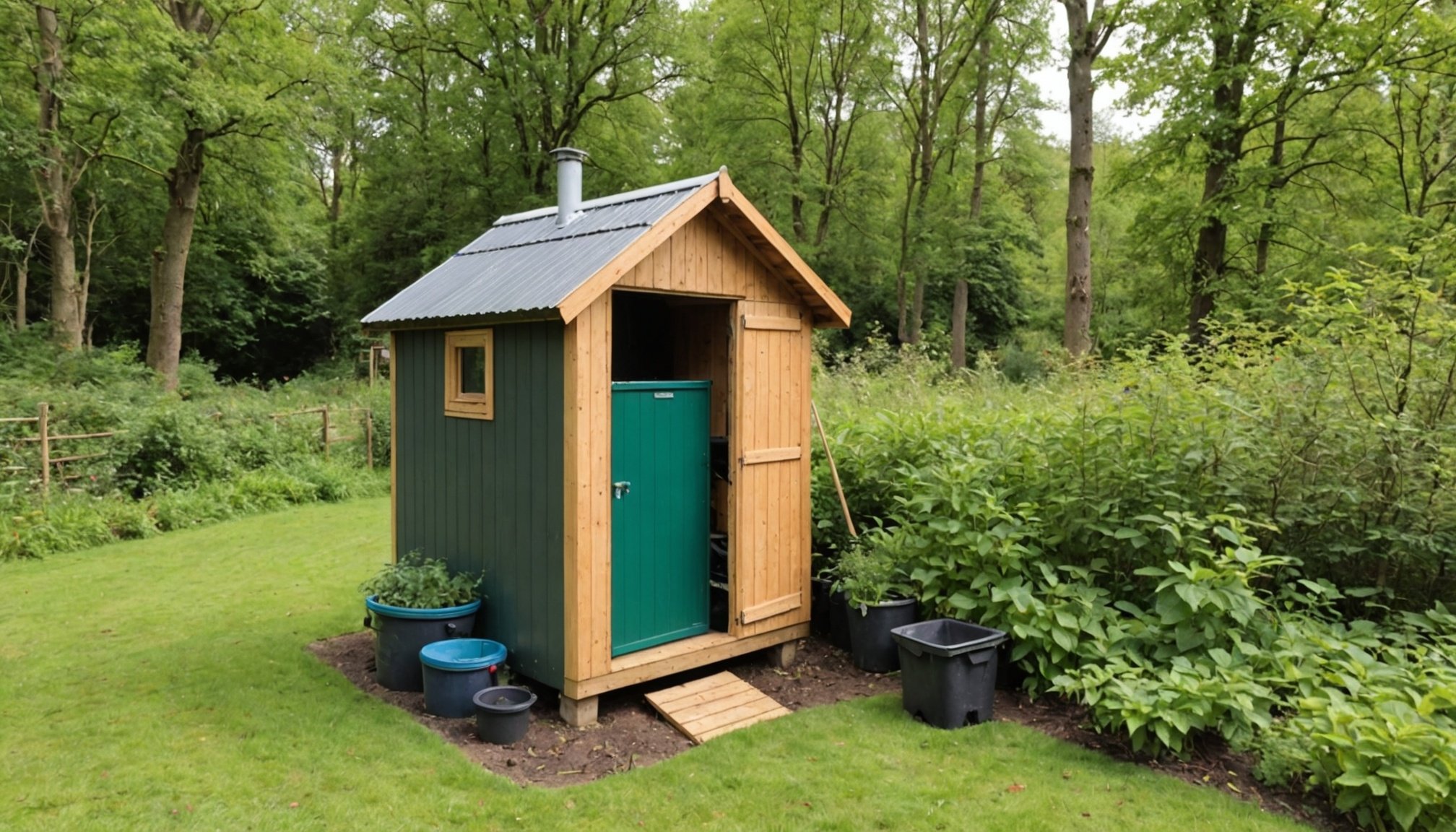Overview of Composting Toilets
Composting toilets offer a sustainable waste management solution by breaking down human waste into compost. There are various types of composting toilets, including self-contained units and central composting units, each serving different needs and capacities. Self-contained composting toilets are integrated systems suitable for small spaces, while central units are designed for larger facilities, requiring separate compost chambers.
The benefits of composting toilets are significant. Primarily, they contribute to environmental sustainability by minimizing water usage, as they do not require flushing. Traditional toilet systems consume vast amounts of water; however, composting toilets use little to none. They further contribute to sustainable waste management by reducing the volume of waste directed to sewage systems, alleviating pressure on municipal facilities and decreasing the likelihood of water contamination.
Also to read : Thriving hydroponics in small spaces: the ultimate guide for uk residents to cultivate an abundant garden in your compact flat
In comparison to traditional toilet setups, composting toilets offer the added advantage of turning waste into valuable compost, enriching soil and promoting safer ecosystems via nutrient recycling. They are a practical choice for off-grid living, remote locations, or areas struggling with water scarcity. Overall, the environmental benefits, combined with the reduction in water waste and contribution to sustainable resource cycles, make composting toilets a compelling option for eco-conscious individuals.
Installation Tips
When setting up composting toilets for the first time, considering off-grid living and site selection is crucial. Choose a location that supports optimal functionality, including easy access for maintenance. Ensure the selected site adheres to any local regulations regarding water supply and waste management.
Also read : Enhance your home”s energy efficiency: ultimate diy window insulation strategies for homeowners in the uk
You’ll need essential components such as venting systems, which prevent odours by allowing gas to escape, and a compost chamber to collect waste. A urine diverter can also enhance functionality by separating liquids, aiding in moisture control within the system. Before starting the actual installation, carefully read the user manual specific to your model for precise instructions.
Installation guide tip: Begin by preparing the ground, ensuring the surface is level. Secure the base of the toilet, attach ventilation and urine-diversion systems, and connect power sources if required.
Though the setup is straightforward, it is vital to ensure proper assembly to maximize performance and ensure the installation guide steps are adhered to. Attention to these details results in a cost-effective system ready to serve the needs of sustainable off-grid living. This not only supports environmental efforts but provides significant long-term savings on water and sewage costs.
Environmental Benefits
Composting toilets provide significant environmental impact by reducing water usage substantially. These systems require minimal to no water, conserving this critical resource. Traditional toilets, in contrast, use substantial amounts of water for flushing, contributing to water scarcity. The adoption of composting toilets aids in water conservation, making them a more sustainable choice.
Additionally, composting toilets positively affect landfill waste reduction. By converting human waste into compost instead of sending it to landfills, these systems decrease the volume of waste that municipal facilities need to manage. This shift leads to lesser environmental damage and helps reduce greenhouse gas emissions typically produced by waste decomposition in landfills.
Another notable composting benefit is the enhancement of soil quality and ecosystem health. The compost produced by these toilets enriches the soil with nutrients, promoting healthier plant growth and more resilient ecosystems. This not only fosters biodiversity but also supports sustainable agriculture practices by replenishing essential nutrients in the soil naturally.
In conclusion, the environmental benefits of composting toilets are considerable, encompassing water conservation, reduced landfill burden, and improved soil quality, making them a vital component of sustainable waste management strategies.
Common Concerns and Solutions
Composting toilets, while beneficial, come with certain user concerns. Odor issues are often a top worry. Users may fear unpleasant smells, but with proper maintenance, this problem is easily managed. Regular use of carbon-rich materials like sawdust or coconut coir helps balance the system and control odors effectively. Ventilation is crucial; ensure sufficient airflow to aid odor elimination.
Handling extreme weather conditions is another challenge. In colder climates, the decomposition process can slow down, potentially causing system efficiency drop. Consider using an insulating cover or heat mats to maintain optimal internal temperature. In contrast, hot weather may increase microbial activity too rapidly. Regularly adjusting charcoal or filter levels can help maintain balance, preventing issues.
For families and larger households, capacity management is essential. Choosing a model designed for higher usage can alleviate waste management challenges. Additionally, integrating a urine diversion system reduces liquid load, enhancing the system’s efficiency.
Addressing these practical advice concerns involves implementing problem-solving strategies tailored to these common issues. Familiarity with user manuals, adopting routine checks, and applying these techniques ensure a smoother experience using composting toilets, enhancing their attractiveness as a sustainable solution.
Cost-Effectiveness
Understanding the cost savings associated with composting toilets is essential for evaluating their financial benefits in both initial outlay and long-term use. On the surface, composting toilets may appear to require a meaningful initial investment compared to traditional systems due to their unique components and technologies. However, this upfront cost often leads to long-term savings through reduced water bills and lower sewage costs. The absence of significant plumbing requirements further reduces installation expenses, especially critical in remote or off-grid settings.
Maintenance costs for composting toilets are generally lower than conventional toilets. Regular tasks, such as replenishing compost materials, are straightforward and inexpensive. Operational costs tend to be minimal since there’s no water flush involved, which contributes to financial efficiency over time.
Homeowners may also explore grants or subsidies available for sustainable systems. Many regions encourage the adoption of eco-friendly technologies by offering financial incentives. Such funds can significantly offset initial costs, making composting toilets a more viable option for budget-conscious individuals. When considering financial benefits, it’s crucial to evaluate both ongoing savings and potential funding opportunities to understand the monetary value composting toilets present over the lifespan of the system.
Maintenance Guidelines
Ensuring optimal performance for composting toilets involves understanding regular maintenance routines and common troubleshooting strategies. These maintenance tips are crucial for maintaining the functionality and longevity of the system.
Regular check-ups should include adding carbon-rich materials such as sawdust or coconut coir to manage moisture levels and control odours. Routine emptying of compost chambers is vital to prevent overflow and maintain efficiency. Following the user manual ensures you’re using the right materials and procedures, which often includes guidelines for frequency of adding and emptying materials.
Troubleshooting common issues like odour or slow decomposition can often be addressed by adjusting the balance of composting materials. Introducing more carbon if the system becomes too moist or reducing input if it’s too dry can help maintain the ideal composting conditions.
Incorporating ventilation and moisture control strategies is essential. Ensure that vent systems function properly to help gases escape and reduce odours. This balance between materials and airflow is critical.
Being proactive in composting toilet care not only ensures optimal performance but also reduces the likelihood of problems developing, thus making them a more reliable choice for sustainable waste management solutions over time.
UK-Specific Regulations
Understanding UK regulations is vital for anyone considering installing composting toilets. The UK has specific legal requirements that aim to ensure both environmental safety and public health. Compliance begins with familiarizing oneself with local council regulations. Councils may have guidelines regarding waste treatment and disposal, ensuring that installation methods do not negatively impact water sources or wildlife.
Legal considerations include adherence to regulations set by the Environment Agency, which may necessitate obtaining permits for larger or centrally located composting systems. It’s essential to understand these compliance requirements to avoid any legal issues post-installation.
Navigating planning permission can often seem daunting but is a crucial step. Depending on the scale and location of the installation, you might need to submit a planning application. Understanding the specific guidelines related to composting toilets can streamline this process. Consulting with a local authority can provide insights into any additional requirements that might be necessary for sustainably-implemented systems.
Aligning with the legal framework ensures that one’s composting efforts are both responsible and recognized by regulatory bodies, aiding in the integration of these eco-friendly solutions into everyday life while adhering to crucial legal standards.
User Testimonials
Real-world experiences from homeowners provide valuable insights into the user experiences with composting toilets. For those living off-grid, these toilets have often proved transformative. A common theme is the shift towards a sustainable lifestyle, with many users sharing how the reduced water usage aligned well with their eco-conscious goals.
One success story from an off-grid community member highlights the adaptability of composting toilets in remote locations. Initially skeptical about potential odor issues, the user was pleasantly surprised by the effectiveness of simple odor-controlling measures. The use of carbon-rich materials and proper ventilation made maintenance straightforward.
Moreover, community insights play a crucial role in supporting new users. Sharing strategies for handling varying waste volumes or troubleshooting common challenges like odor or moisture levels fosters a cooperative approach. This communal knowledge often results in innovative problem-solving and heightened confidence among users.
These success stories underline the significant lifestyle changes composting toilets can bring, demonstrating their capacity to promote sustainable living. By embracing such systems, users have found practical ways to contribute positively to sustainable waste management, encouraging others to consider making this eco-friendly shift.
Product Recommendations
Selecting the right composting toilet brands is crucial for a seamless experience in sustainable waste management. Each brand offers distinctive features and progresses towards eco-friendly living.
- Nature’s Head is renowned for its rugged design and ease of maintenance, suiting off-grid living excellently and ensuring dependable composting benefits. Users frequently commend it for durability and straightforward assembly.
- Clivus Multrum is revered for its extensive capacity and ability to service larger households with fewer emptying cycles, making it ideal for busy homes or community settings.
- Separett is lauded for its modern design and effective urine diversion system, enhancing the functionality and efficiency of the composting process while maintaining aesthetic appeal.
User testimonials highlight satisfaction with these brands, reflecting positive real-world experiences. They often note the long-term cost savings and reduction in environmental impact, thus aligning well with sustainable living ideals.
In terms of best practices, it’s vital to follow specific guidelines provided by each brand, ensuring longevity and optimal performance. Exploring product reviews and community feedback offers insights into practical applications and maintenance realities, helping potential buyers make informed, environmentally conscious decisions. These choices advance towards a lifestyle that champions efficiency, durability, and ecological responsibility.





